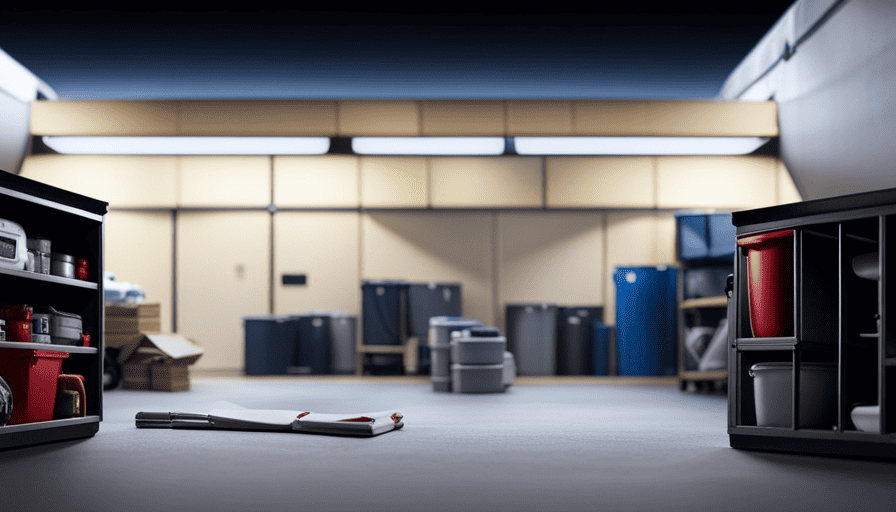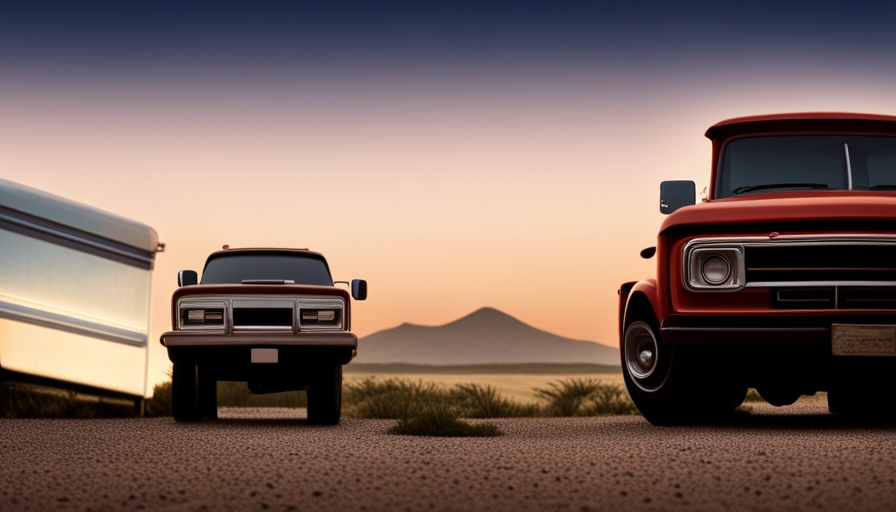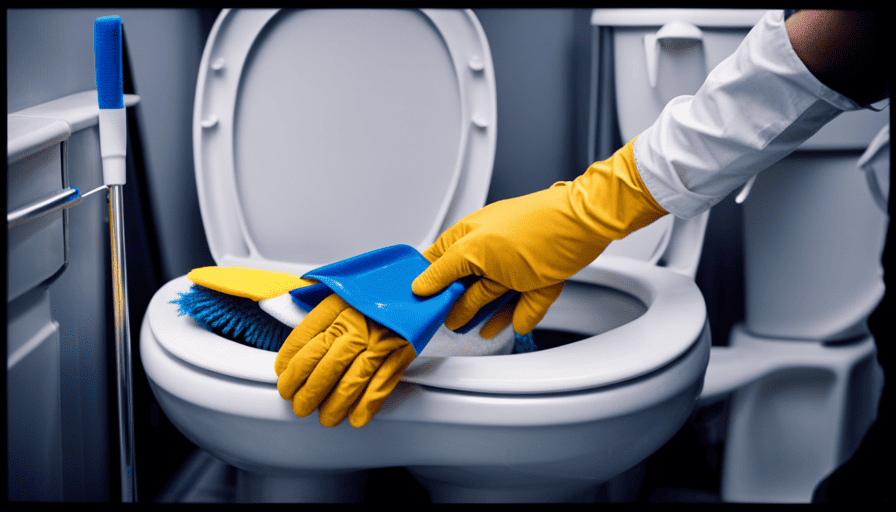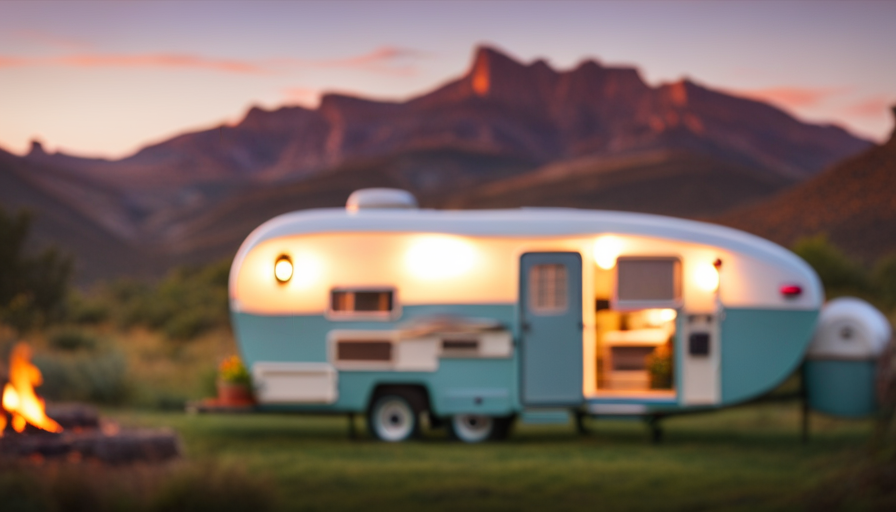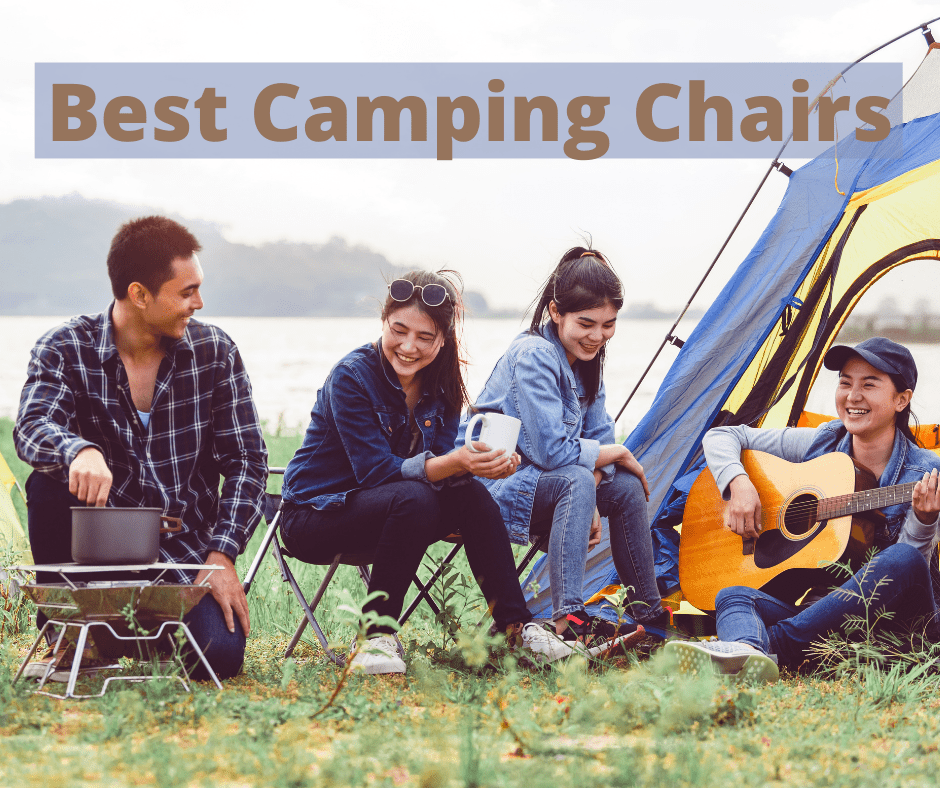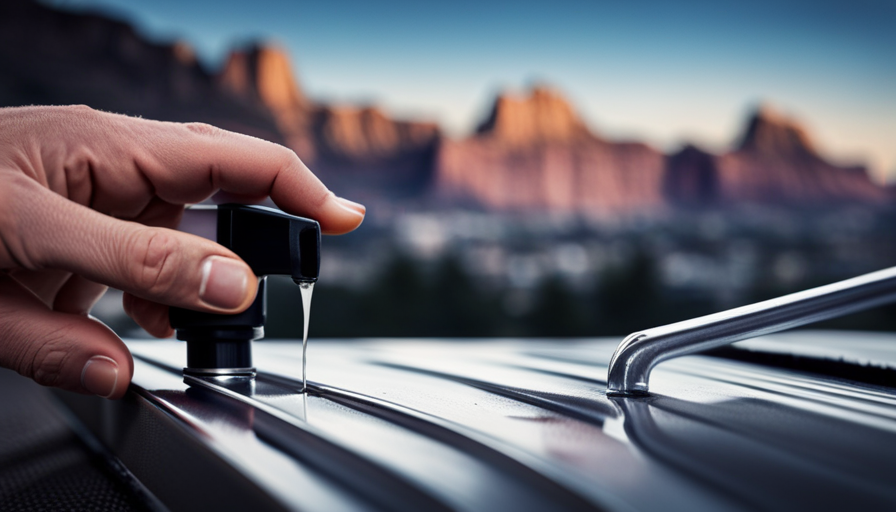Are you prepared to say goodbye to the open highways and snugly tuck your beloved pop-up camper into a nice, cozy storage area?
As the seasons change and camping adventures come to a close, it’s time to learn the art of properly storing your beloved home away from home.
In this article, we will guide you through the essential steps to ensure your pop-up camper remains in top-notch condition during its hibernation period.
From cleaning and organizing the interior to securing and protecting the exterior, we’ve got you covered.
With our expert tips and tricks, you’ll be able to bid adieu to the camping season with confidence, knowing that your pop-up camper is safely tucked away until the next adventure beckons.
So, let’s dive in and discover the secrets to storing a pop-up camper like a pro!
Key Takeaways
- Cleaning and organizing the interior is important for storing a pop-up camper during the off-season.
- Inspecting and repairing damages and wear and tear is necessary to ensure the camper is in good condition for storage.
- Properly draining and cleaning water tanks and lines is essential to prevent freezing and damage.
- Securing and protecting the exterior of the pop-up camper is crucial to maintain its condition during storage.
Clean and Organize the Interior of Your Pop-Up Camper
Get ready to transform your pop-up camper into a tidy and inviting home-on-wheels by cleaning and organizing its cozy interior. Cleaning products are essential for maintaining a fresh living space. Start by wiping down all surfaces with a mild cleaning solution and a soft cloth. Don’t forget to tackle those hard-to-reach spots, like the corners and crevices. For stubborn stains, use a specialized cleaner that’s safe for the camper’s materials.
Pay extra attention to the kitchen area, where food spills and grease can accumulate. Make sure to clean the stove, sink, and countertops thoroughly.
Storage organization is key to maximizing space in your pop-up camper. Utilize storage bins and baskets to keep items organized and easily accessible. Install hooks on the walls to hang towels, jackets, and other essentials. Consider using collapsible furniture and nesting cookware to save space. Utilize under-bed storage for larger items like camping chairs and folding tables. Don’t forget to label the storage containers for easy identification.
Inspect and repair any damages or wear and tear. Look for leaks, loose screws, and worn-out seals. Replace damaged parts and tighten any loose fittings.
By taking the time to clean, organize, and inspect your pop-up camper, you’ll ensure it’s in top shape for your next adventure.
Now, let’s move on to the next section and discuss how to inspect and repair any damages or wear and tear.
Inspect and Repair Any Damages or Wear and Tear
Examine and fix any damages or signs of wear and tear to ensure your beloved camper is in top shape. Regularly inspecting and repairing your pop-up camper is essential for a safe and enjoyable camping experience.
Here are some key areas to focus on:
-
Canvas: Carefully examine the canvas for any tears or holes. Repair them promptly to prevent further damage and to keep insects and moisture out.
-
Roof and Seals: Check the roof for any cracks or leaks. Inspect the seals around windows, doors, and seams for any signs of deterioration. Replace or repair any damaged areas to prevent water from seeping in.
-
Appliances and Systems: Inspect all appliances, such as the stove, refrigerator, and air conditioner, for any malfunctions or wear. Test the electrical and plumbing systems to ensure they’re in proper working order.
By thoroughly inspecting and repairing any damages or wear and tear, you can extend the lifespan of your pop-up camper and avoid costly repairs down the road.
Once you’ve completed this step, it’s time to empty and clean all water tanks and lines to ensure they’re ready for your next camping adventure.
Empty and Clean All Water Tanks and Lines
Make sure to thoroughly empty and clean all water tanks and lines, ensuring they’re fresh and ready for your next unforgettable camping adventure. Properly emptying the water tanks is an essential step in winterizing your camper.
Start by locating the drain valves for both the fresh water and gray water tanks. Open these valves and let all the water drain out completely. It’s important to remove any residual water to prevent freezing and potential damage to the tanks and lines during colder months.
Once the tanks are empty, proceed to clean them using a mixture of water and RV-safe cleaning solution. Scrub the inside of the tanks with a long-handled brush to remove any dirt, debris, or bacteria that may have accumulated. Rinse the tanks thoroughly until the water runs clear, ensuring there are no traces of cleaning solution left behind.
In addition to the tanks, it’s crucial to clean the water lines as well. Use a specialized RV water line cleaner and follow the manufacturer’s instructions to flush out any sediments or contaminants that may have built up. This will help maintain the integrity and longevity of your camper’s plumbing system.
With the water tanks and lines emptied and cleaned, you can now move on to the next step of preparing your pop-up camper for storage: removing and cleaning all bedding and upholstery.
Remove and Clean All Bedding and Upholstery
To ensure a fresh and cozy camping experience, you’ll want to remove and clean all the bedding and upholstery, adding a touch of comfort to your camper’s interior. Imagine sinking into clean sheets and snuggling up in a warm blanket as you embark on your next adventure.
Cleaning the bedding and upholstery is an essential step in maintaining a hygienic and inviting living space in your pop-up camper. Start by removing all the bedding, including sheets, pillowcases, and blankets. Launder them according to the manufacturer’s instructions, using a mild detergent and warm water. For stubborn stains, pretreat with a stain remover before washing.
Next, tackle the upholstery. Use a handheld vacuum or a brush attachment to remove any loose dirt and debris. For fabric upholstery, check the care instructions and use an appropriate cleaner to spot clean any stains. For leather upholstery, use a leather cleaner and conditioner to keep it looking supple and luxurious.
Once everything is clean and dry, neatly fold and store the bedding in a designated storage bag or container. This will help keep everything organized and ready for your next camping trip. As for the upholstery, consider using vacuum-sealed storage bags to minimize space and protect them from dust and moisture.
Now that your bedding and upholstery are fresh and clean, it’s time to move on to the next step: properly deflate and store the awning.
Properly Deflate and Store the Awning
Now that you’ve got a fresh and cozy interior, it’s time to deflate and neatly pack away the awning for your next outdoor adventure. Deflating the awning is an essential step in maintaining its longevity and ensuring it stays in good condition for future use.
Start by removing any accessories or attachments from the awning, such as lights or decorations. Then, locate the valve that controls the air pressure and open it to release the air. Gently push down on the awning to help it deflate fully.
Once the awning is deflated, it’s important to store it properly to prevent any damage. Find a clean and dry storage location, such as a garage or a shed, where the awning can be protected from the elements. Lay it flat on the ground or hang it up to avoid any creases or folds that could lead to permanent damage. Make sure to secure it with straps or ties to keep it in place.
Now that your awning is deflated and safely stored, it’s time to move on to the next step of checking and maintaining the battery and electrical system.
Check and Maintain the Battery and Electrical System
Ensure the battery and electrical system of our camper are in tiptop shape to guarantee a trouble-free trip. Start by checking the battery life to ensure it’s fully charged. A dead battery can put a damper on your camping experience, so it’s essential to have a reliable power source.
If the battery is low, connect it to a charger and let it charge overnight. Additionally, inspect the battery terminals for any corrosion and clean them if necessary.
Next, troubleshoot any electrical issues that may arise. Check all the lights, both inside and outside the camper, to ensure they’re working properly. Test the outlets to make sure they’re providing power. If you encounter any problems, begin by checking the fuses and replacing any that are blown. It’s also a good idea to have a basic understanding of your camper’s electrical system and keep a spare fuse kit on hand.
By properly maintaining the battery and electrical system, you can avoid any unexpected issues on your camping trip.
Now that you’ve checked and maintained the battery and electrical system, it’s time to move on to the next step: securing and protecting the exterior of your pop-up camper. This will help ensure that your camper is ready for storage and protected from the elements.
Secure and Protect the Exterior of Your Pop-Up Camper
Make sure the exterior of your pop-up camper is properly secured and protected to ensure its safety and longevity. When it comes to storing your camper, weatherproofing techniques are vital in preventing damage from the elements.
Start by thoroughly cleaning the exterior and removing any dirt or debris. This will help prevent scratches and rust. Next, apply a protective coating or wax to the exterior surfaces to provide a barrier against moisture and UV rays.
Additionally, inspect and repair any cracks or gaps in the seams, windows, and doors to prevent water leaks. Investing in recommended storage accessories such as covers, tire covers, and wheel locks can further protect your camper from dust, dirt, and theft. These accessories will help preserve its appearance and functionality during the storage period.
Lastly, consider finding a suitable storage space or facility that offers protection from extreme weather conditions, pests, and theft. By taking these steps to secure and protect the exterior of your pop-up camper, you can ensure it remains in top condition until your next adventure.
Now, let’s explore how to find a suitable storage space or facility for your camper.
Find a Suitable Storage Space or Facility
Discover the perfect storage solution that’ll provide peace of mind and keep your beloved adventure companion safe from harm. When it comes to finding affordable storage options for your pop-up camper, there are a few key factors to consider.
First, assess the size of your camper and determine if it’ll fit in a standard storage unit or if you need to look for outdoor storage options. Many storage facilities offer outdoor parking spaces specifically designed for RVs and campers. These spaces typically provide ample room and security features to protect your camper.
Once you’ve found a suitable storage space or facility, it’s important to organize it effectively to maximize space and keep your camper protected. Start by clearing out any unnecessary items from the storage space to make room for your camper. Consider investing in shelving or storage bins to keep your camping gear and accessories organized and easily accessible. Utilize wall hooks or hanging storage solutions to keep smaller items off the floor and prevent them from getting lost or damaged.
As you organize your storage space, keep in mind the importance of protecting your pop-up camper from the elements. In the next section, we’ll discuss how to cover and protect your camper to ensure its longevity and durability.
Cover and Protect Your Pop-Up Camper from the Elements
To keep your beloved adventure companion safe and protected, it’s important to cover and shield your pop-up camper from the elements, increasing its lifespan by an average of 10 years. Here are some weatherproofing tips and advice for choosing the right cover:
-
Weatherproofing tips:
- Clean and dry: Before covering your camper, make sure it’s clean and dry to prevent any mold or mildew growth.
- Seal all openings: Use weatherstripping or silicone to seal any gaps or openings to keep water, dust, and pests out.
- Protect the tires: Invest in tire covers to prevent cracking and damage from the sun’s UV rays.
-
Choosing the right cover:
- Material: Look for a cover made from durable, waterproof material like polyester or polypropylene.
- UV protection: Ensure the cover offers UV protection to prevent fading and deterioration of your camper’s exterior.
- Custom fit: Get a cover that fits your specific camper model snugly to avoid any flapping or damage during strong winds.
By following these weatherproofing tips and choosing the right cover, you can keep your pop-up camper safe and protected from the elements.
In the next section, we’ll discuss how to create a checklist for easy setup and future use, ensuring hassle-free camping adventures.
Create a Checklist for Easy Setup and Future Use
Ensure a hassle-free camping experience by creating a checklist that’ll help us easily set up and utilize our pop-up camper in the future. Checklist organization is key to ensuring an efficient setup process.
Start by organizing the checklist into different categories such as equipment, supplies, and safety. This’ll help us stay organized and ensure that we don’t forget any essential items.
When it comes to equipment, make sure to include items like leveling blocks, wheel chocks, and a crank handle for raising and lowering the camper. Don’t forget to check that all the lights and appliances are in working order before each trip.
In terms of supplies, include items like bedding, cooking utensils, and toiletries. It’s also a good idea to include a first aid kit and a fire extinguisher for safety purposes.
To make the setup process even more efficient, consider creating a step-by-step guide that outlines the order in which things should be done. This’ll help us save time and avoid any unnecessary confusion or mistakes.
By creating a checklist and organizing it in a thoughtful manner, we can ensure that our pop-up camper setup process is efficient and hassle-free. So, let’s get started and make our camping trips even more enjoyable!
Frequently Asked Questions
How do I properly winterize my pop-up camper?
To properly winterize a pop-up camper, we need to follow the proper winterization techniques. This involves protecting the canvas and seals from the harsh winter elements.
Start by thoroughly cleaning the camper and ensuring all water systems are drained. Apply a protective sealant to the canvas, paying special attention to any seams or areas prone to leaks.
Cover the camper with a breathable, waterproof cover to further protect it from the elements.
Can I leave my pop-up camper fully set up while it’s in storage?
Yes, you can leave your pop-up camper fully set up while it’s in storage. However, it’s important to follow some winter storage tips and perform a maintenance checklist before doing so. This includes cleaning the camper thoroughly, checking for any leaks or damage, draining the water system, removing perishable items, and covering the camper with a breathable cover.
By following these steps, you can ensure that your pop-up camper remains in good condition during the winter months.
How often should I check the tires on my pop-up camper while it’s in storage?
Regularly checking the tires on your pop-up camper while it’s in storage is crucial to ensure its safety and longevity. Neglecting this task can lead to potential issues such as tire degradation or even blowouts while on the road.
To prevent rust on your camper, it’s advisable to store it in a dry and well-ventilated space. Additionally, using protective covers and applying rust-preventive sprays can further safeguard your camper. Researching the best storage solutions for pop-up campers can provide you with additional options to keep your camper in top shape.
Should I remove the propane tanks from my pop-up camper before storing it?
When it comes to propane tank safety and pop-up camper storage tips, it’s recommended to remove the propane tanks before storing the camper. This is important to ensure the safety of the camper and to prevent any potential gas leaks or accidents.
Before removing the tanks, make sure to turn off the gas supply and disconnect the tanks properly. Store them in a well-ventilated area away from any sources of ignition.
What should I do if I notice water damage or mold inside my pop-up camper during storage?
To prevent water damage in a pop-up camper during storage, there are a few key steps. First, inspect the camper for any leaks or cracks and seal them with silicone caulk.
Next, ensure proper ventilation by opening windows slightly or using a dehumidifier.
To remove mold, mix a solution of bleach and water, scrub affected areas, and then thoroughly dry.
Regularly checking for water damage and mold will help preserve your camper for future use.
Conclusion
In conclusion, storing a pop-up camper is like tucking away a cherished memory in a treasure chest. Just as we carefully clean and organize the interior, inspect every nook and cranny for damages, and empty all the water tanks, we are preserving the essence of our adventures.
By deflating the awning, securing the exterior, and finding a suitable storage space, we ensure its safety. Lastly, by covering and protecting it from the elements, we guard against the passage of time.
With a checklist in hand, we can easily relive those magical moments and embark on new journeys. Happy camping!

